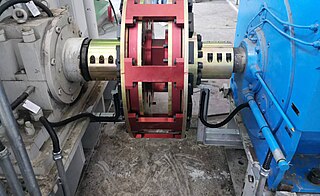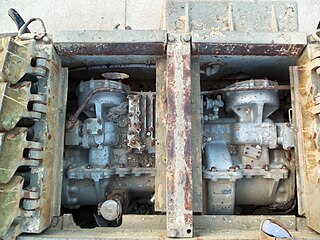
A clutch is a mechanical device that allows the output shaft to be disconnected from the rotating input shaft. The clutch's input shaft is typically attached to a motor, while the clutch's output shaft is connected to the mechanism that does the work.

An automatic transmission is a multi-speed transmission used in motor vehicles that does not require any input from the driver to change forward gears under normal driving conditions. Vehicles with internal combustion engines, unlike electric vehicles, require the engine to operate in a narrow range of rates of rotation, requiring a gearbox, operated manually or automatically, to drive the wheels over a wide range of speeds.

Dynamic braking is the use of an electric traction motor as a generator when slowing a vehicle such as an electric or diesel-electric locomotive. It is termed "rheostatic" if the generated electrical power is dissipated as heat in brake grid resistors, and "regenerative" if the power is returned to the supply line. Dynamic braking reduces wear on friction-based braking components, and regeneration lowers net energy consumption. Dynamic braking may also be used on railcars with multiple units, light rail vehicles, electric trams, trolleybuses, and electric and hybrid electric automobiles.

A torque converter is a device, usually implemented as a type of fluid coupling, that transfers rotating power from a prime mover, like an internal combustion engine, to a rotating driven load. In a vehicle with an automatic transmission, the torque converter connects the prime mover to the automatic gear train, which then drives the load. It is thus usually located between the engine's flexplate and the transmission. The equivalent device in a manual transmission is the mechanical clutch.

A transmission is a mechanical device which uses a gear set—two or more gears working together—to change the speed or direction of rotation in a machine. Many transmissions have multiple gear ratios, but there are also transmissions that use a single fixed-gear ratio.

A continuously variable transmission (CVT) is an automated transmission that can change through a continuous range of gear ratios. This contrasts with other transmissions that provide a limited number of gear ratios in fixed steps. The flexibility of a CVT with suitable control may allow the engine to operate at a constant angular velocity while the vehicle moves at varying speeds.

Hydraulic machines use liquid fluid power to perform work. Heavy construction vehicles are a common example. In this type of machine, hydraulic fluid is pumped to various hydraulic motors and hydraulic cylinders throughout the machine and becomes pressurized according to the resistance present. The fluid is controlled directly or automatically by control valves and distributed through hoses, tubes, or pipes.

Hydramatic is an automatic transmission developed by both General Motors' Cadillac and Oldsmobile divisions. Introduced in 1939 for the 1940 model year vehicles, the Hydramatic was the first mass-produced fully-automatic transmission developed for passenger automobile use.
Turbo-Hydramatic or Turbo Hydra-Matic is the registered tradename for a family of automatic transmissions developed and produced by General Motors. These transmissions mate a three-element turbine torque converter to a Simpson planetary geartrain, providing three forward speeds plus reverse.

Motor drive means a system that includes a motor. An adjustable speed motor drive means a system that includes a motor that has multiple operating speeds. A variable speed motor drive is a system that includes a motor and is continuously variable in speed. If the motor is generating electrical energy rather than using it – this could be called a generator drive but is often still referred to as a motor drive.

British Railways 10100 was an unusual experimental diesel locomotive known informally as The Fell Diesel Locomotive. It was the joint production of Davey Paxman & Co, Shell Refining & Marketing Co and Lt-Col L. F. R. Fell, built for them by the London, Midland and Scottish Railway at Derby. Sir Harry Ricardo was also involved. By the time it emerged in 1950, nationalisation had taken place and it carried British Railways livery. The locomotive had six diesel engines, four of them used for traction. There were two auxiliary engines, both of which were 150 hp (110 kW) AEC 6-cylinder units, and these drove the pressure-chargers for the main engines and the purpose of this arrangement was to enable the main engines to deliver very high torque at low crankshaft speed.

A magnetic coupling is a component which transfers torque from one shaft to another using a magnetic field, rather than a physical mechanical connection. They are also known as magnetic drive couplings, magnetic shaft couplings, or magnetic disc couplings.

A hydraulic motor is a mechanical actuator that converts hydraulic pressure and flow into torque and angular displacement (rotation). The hydraulic motor is the rotary counterpart of the hydraulic cylinder as a linear actuator. Most broadly, the category of devices called hydraulic motors has sometimes included those that run on hydropower but in today's terminology the name usually refers more specifically to motors that use hydraulic fluid as part of closed hydraulic circuits in modern hydraulic machinery.
The Turboglide is a Chevrolet constant torque, continuously variable automatic transmission first offered as an option on Chevrolet V8 passenger cars for 1957. It consisted of a turbine-driven planetary gearbox with a 'switch pitch' dual-pitch torque converter stator. It had a die-cast aluminum transmission case, like Packard's Ultramatic of 1956. Turboglide cost about $50 more than the Powerglide 2-speed automatic. It was available in all V8-powered 1957-1961 Chevrolet models except the Corvette. General Motors produced 646,000 of these transmissions during its production.
Turbo transmissions are hydrodynamic, multi-stage drive assemblies designed for rail vehicles using internal combustion engines. The first turbo-transmission was developed in 1932 by Voith in Heidenheim, Germany. Since then, improvements to turbo-transmissions have paralleled similar advances in diesel motors and today this combination plays a leading role worldwide, second only to the use of electrical drives.
Stall torque is the torque produced by a mechanical device whose output rotational speed is zero. It may also mean the torque load that causes the output rotational speed of a device to become zero, i.e., to cause stalling. Electric motors, steam engines and hydrodynamic transmissions are all capable of developing torque when stalled.

A cross-drive steering transmission is a transmission, used in tracked vehicles to allow precise and energy-efficient steering.

SNCF BB 69000 were a pair of two prototype high-power diesel-hydraulic locomotives, numbered BB 69001 and BB 69002. They were built at the same time, and for comparison with, as a diesel-electric version, CC 70000. The use of hydraulic transmission saved 30 tons in weight and enabled the locomotives to run on four axles instead of the six axles of the diesel-electric.
The Mercedes-Benz first series of automatic transmission was produced from 1961 to 1983 in four- and three-speed variants for Mercedes-Benz passenger cars. In addition, variants for commercial vehicles were offered.

An internal combustion locomotive is a type of railway locomotive that produces its pulling power using an internal combustion engine. These locomotives are fuelled by burning fossil fuels, most commonly oil or gasoline, to produce rotational power which is transmitted to the locomotive's driving wheels by various direct or indirect transmission mechanisms. The fuel is carried on the locomotive.



















